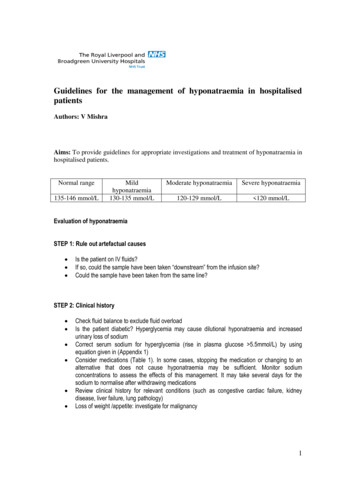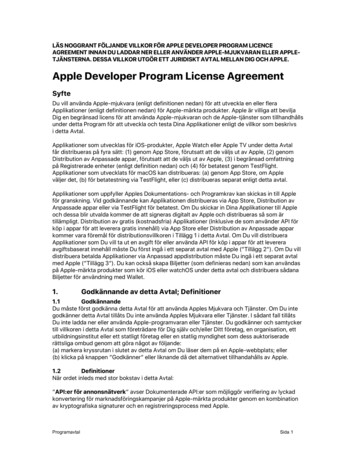
Transcription
Guidelines for the management of hyponatraemia in hospitalisedpatientsAuthors: V MishraAims: To provide guidelines for appropriate investigations and treatment of hyponatraemia inhospitalised patients.Normal range135-146 mmol/LMildhyponatraemia130-135 mmol/LModerate hyponatraemiaSevere hyponatraemia120-129 mmol/L 120 mmol/LEvaluation of hyponatraemiaSTEP 1: Rule out artefactual causes Is the patient on IV fluids?If so, could the sample have been taken “downstream” from the infusion site?Could the sample have been taken from the same line?STEP 2: Clinical history Check fluid balance to exclude fluid overloadIs the patient diabetic? Hyperglycemia may cause dilutional hyponatraemia and increasedurinary loss of sodiumCorrect serum sodium for hyperglycemia (rise in plasma glucose 5.5mmol/L) by usingequation given in (Appendix 1)Consider medications (Table 1). In some cases, stopping the medication or changing to analternative that does not cause hyponatraemia may be sufficient. Monitor sodiumconcentrations to assess the effects of this management. It may take several days for thesodium to normalise after withdrawing medicationsReview clinical history for relevant conditions (such as congestive cardiac failure, kidneydisease, liver failure, lung pathology)Loss of weight /appetite: investigate for malignancy1
Table 1: Drugs known to cause hyponatraemiaDrug groupThiazide diureticsLoop diureticsPotassium-sparing diureticsCombined diureticsExamples known to cause hyponatraemia (other compounds may exist)Bendroflumethiazide, Metolazone, Indapamide, ChlortalidoneFurosemide, Bumetanide, TorasemideAmiloride, Spironolactone, Triamterene, EplerenoneCo-amilofruse, Co-amilozideCandesartanAngiotensin II receptor antagonistsTricyclic (& related)antidepressantsSSRIsMAO inhibitorsProton pump inhibitorsAnticonvulsantsOthersAmitriptyline, Clomipramine, Dosulepin, Imipramine, Nortriptyline, Trimipramine, Mianserin,TrazodoneCitalopram, Fluoxetine, Fluvoxamine, Paroxetine, SertralinePhenelzine, Isocarboxazid, Tranylcypromine, MoclobemideOmeprazoleCarbamazepine, ValproateVenlafaxine, Duloxetine, Chlorpropamide, Glimeripide, GlipizideSTEP 3: Clinical examination to assess extracellular volume (Appendix 2) Hypovolaemia: Signs of dehydration, such as hypotension, tachycardia, oliguria, dry oralmucosa, reduced skin turgor, reduced central venous pressureEuvolaemia: Normal blood pressure, pulse rate, central venous pressureHypervolaemia: Pedal oedema/ascitesClinical findings must be considered when requesting and interpreting the results of laboratoryinvestigationsSTEP 4: Biochemical investigationSamples should be sent to the laboratory for the following investigations as soon as possible, andpreferably before starting treatment: Paired serum and spot urine for U&E and osmolality Plasma glucoseIf there is suspicion of adrenal insufficiency or severe hypothyroidism, the following investigationsshould be performed: 9 am serum for cortisol; if equivocal, a short synacthen test may be necessary Thyroid function testsHyponatraemia may be categorised into three types, depending on the extracellular fluid volume andbiochemical investigations.When requesting tests through ICE (RLBUHT), click on the “Hyponatraemia investigations” linkfor a list of tests that should be requested to investigate a patient with hyponatraemiaWhen requesting tests through Medway (AUH), request blood biochemistry(U&E, TFT, cortisol,glucose, osmolality) and urine (U&E and osmolality)2
Figure 1: Flowchart to aid in diagnosis of underlying causes of hyponatraemiaExclude artefactual causesYesCheck medicationsIs patient on medications listed in Table 1?YesCheck fluid balanceIs patient in positive fluid balance?Discontinue medicationsMonitor serum sodium for 2 to 3 daysDiscontinue IV fluids, start fluid restrictionMonitor serum sodium for 2 to 3 daysSend hyponatraemia investigations(ICE/MEDWAY)Assess patient’s volume status clinicallyHypovolaemiaRenal or extra-renalloss of sodiumEuvolaemiaUrine sodium 30mmol/LMedications (Table 1)Glucocorticoid deficiencySevere HypothyroidismSIADHHypervolaemiaAcute kidney injuryChronic kidney diseaseCongestive cardiac diseaseLiver cirrhosisNephrotic syndrome3
Management of hyponatraemiaTreatment depends on the patient’s Estimated volume status Serum sodium concentration Chronicity Rate of fall of the serum sodium concentrationHypovolaemic hyponatraemia Rehydrate with sodium chloride 0.9% infusion or balanced crystalloid solution (Hartmann) Volume and rate of fluid to be administered in severe chronic hyponatraemia can be calculatedby equation 1(see below) Hartmann (balanced crystalloid solution) should be preferred over normal saline providedpatient does not have hyperkalaemia, alkalosis (raised bicarbonate) and hypercalcaemia Normal saline should be given where there is upper gastrointestinal loss (loss of hydrochloride)or serum chloride 98mmol/L Check U&E after infusion and prescribe further fluids based upon the resultHypervolaemic hyponatraemia Fluid and salt restriction Consider diuretics Treat the underlying causeEuvolaemic hyponatraemia If possible treat the cause (e.g. chest infection, malignancy or hormonal insufficiency)If treating SIADH(Appendix 3)- Commence fluid restriction (500 -750 ml/day)Maintain accurate fluid balance chartMeasure weight of the patient dailyIf serum Na not corrected despite adherence to appropriate fluid restriction, consider Tolvaptan(only after discussion with Endocrinology consultant)4
Management of Severe Symptomatic Hyponatremia (Serum Na 120mmol/L)Patient with severe hyponatraemia presenting with symptoms as shown in Table 2Table 2: Clinical presentation in sever symptomatic HyponatraemiaManagement of severe symptomatic hyponatraemia(Table 2)Patient should be managed in ITU/HDU under close supervision and monitoring 90mls of 5% saline IV (through central line) over 20 min Continue the same dose every 20min Stop the infusion if either happens first serum Na increases by 5 mmol/L clinical improvement in symptoms Recheck serum Na after every infusion doseClinical Improvement after increase in serum Na by 5 mmol/L (calculation 1) Start with normal saline (0.9%) at rate so that serum Na increases by 0.5mmol/L/hour. Overallincrease in serum Na should be 10mmol/L during the first 24 hours additional 8mmol/L for every 24 hours or 18mmol/L in 48hours Continue till serum Na reaches 130mmol/LNo clinical Improvement after increase in serum Na by 5 mmol/L (calculation 2) Continue with 5% saline with rate of increase in serum Na 1mmol/L/hour Stop the infusion if either happens first: improvement in clinical symptoms total increase in serum Na by 10mmol/L Serum Na reaches 130mmol/L Keep checking serum sodium every 4 hourly5
*if symptoms do not improve by increasing the serum Na by 10mmol/L or serum Na reaches130mmol/L ; investigate for any other cause responsible for symptoms other thanhyponatremiaManagement of moderately symptomatic hyponatraemia(Table 2)Patient can be managed on ward as follows 250mls of 1.8% saline IV (through peripheral line) over 20 min Continue the same dose every 20min Stop the infusion if either happens first serum Na increases by 5 mmol/L clinical improvement in symptoms Recheck serum Na after every infusion doseClinical Improvement after increase in serum Na by5 mmol/L (calculation1) Start with normal saline (0.9%) at a rate 0.5 mmol/L/hour so that increase in serum Na 10mmol/L during the first 24 hours additional 8mmol/L for every 24 hours or 18mmol/L in 48hours Continue till serum Na reaches 130mmol/LPlease contact the Duty Biochemist in Clinical Biochemistry or On call Endocrinology SpR(through the switch board) for advice on management of hyponatraemia.6
APPENDICESAppendix 1Equation for correction of serum sodium for hyperglycaemiaCorrected serum Sodium (mmol/L) Measured serum sodium 2.4 X [Serum Glucose (mmol/L)- ------5.5mmol/LAdapted from Hillier et al (1999)Appendix 2 Classification of HyponatraemiaHypovolaemic hyponatraemia Whole body sodium and water depletion, with renal or extra-renal sodium lossExtra-renal loss of sodium stimulates the renin-angiotensin-aldosterone axis, reducing theexcretion of sodium in the urine (urine Na 30 mmol/L)In cases of renal loss (including diuretics), there is increased excretion of sodium (urine Na 30 mmol/L)Clinically these patients present with signs and symptoms of dehydrationHypervolaemic hyponatraemia An excess of sodium and a greater excess of waterAccumulation of interstitial fluid reduces the effective circulating volume, which stimulatesaldosterone and ADH secretion, increasing the reabsorption of sodium and water from thekidneyClinically may present with detectable oedema or ascites due to reduced oncotic pressure,which causes a shift of fluid into the interstitial spaceEuvolaemic hyponatraemia Normal whole body sodium with water excessThe cause of apparently euvolaemic hyponatraemia is often not immediately apparentIn hospitalised patients, a common cause of euvolaemic hyponatraemia is inappropriateintravenous fluidsOther causes of euvolaemic hyponatraemia must be ruled out before the diagnosis of SIADH ismade (see Appendix 2). SIADH should be differentiated from cerebral salt wasting syndrome(see Appendix 2)7
Appendix 3 Criteria for the diagnosis of SIADHCriteria for the diagnosis of SIADH Serum osmolality 275mosm/kgUrine osmolality 100mosm/kgUrine sodium 30mmol/LAbsence of adrenal, thyroid, pituitary or renalinsufficiencyClinically euvolaemicAdapted from Schwartz et al(1957)Appendix 4Management of severe hyponatraemia(serum sodium 120mmol/L)Definition Acute hyponatremia is defined as hyponatremia (serum Na 135mmol/L) presenting within 48hours Symptomatic hyponatremia is defined as any biochemical degree of hyponatremia presentingwith moderately to severe neurological symptoms Symptomatic hyponatremia is usually associated with acute severe hyponatremia at serum Na 120mmol/LPathogenesis of Symptomatic hyponatremia When hyponatremia develops within few hours( 48hours), ability of brain cells to adapt isexceeded and results in cerebral oedema(low osmolality) It is usually seen in post operative conditions associated with excess fluid retention It is a life threatening condition as it can result in severe brain damage or death of the patient After 48 hours (chronic hyponatremia) brain cells adapt by extruding sodium, potassium, chlorideand osmolytes and return to their normal size (normal osmolality). Therefore patients withchronic hyponatremia are asymptomaticClinical presentation of symptomatic hyponatremia The symptoms of acute severe hyponatremia is due to cerebral oedema leading to brainherniation which is life threatening A small increase in serum Na rapidly by 5mmol/L is effective as it increases the osmolality,reduces brain swelling and intracerebral pressure Infusion of hypertonic saline increases the serum Na rapidly and is effective in patients withsymptomatic hyponatremiaNa content : 0.9% saline 154mmol/1000mls 1.8% saline 308mmol/1000mls 5% saline 856mmol/1000mlsTotal body water: Non-elderly men: 0.6 Non-elderly women: 0.5 Elderly men: 0.5 Elderly women: 0.458
Calculations (Adrogue-Madias, NEJM 2000;342:1581-1589)To achieve serum Na at 0.5mmol/L/hour with normal saline (Calculation 1)The following formula can be used to calculate Na replacement using 0.9% saline In order to achieve a 0.5 mmol/h increase in serum Na, use this formula to calculate the amountof intravenous sodium needed per hour (mmol/h): Amount of sodium replacement (mmol/h) 0.6(total body water in non-elderly man) xweight (kg) x 0.5 (desired correction rate mmol/h) When using 0.9% saline (Normal Saline)(1000ml contains 154 mmol sodium) the rate ofinfusion required to achieve a 0.5 mmol/h improvement in serum sodium is given by:Amount of sodium replacement (mmol/h) X (1000/154) ml/hr of 0.9% saline requiredFor Example: for an 80 kg patient 0.6 x 80 x 0.5 24 mmol/hr sodium required 24 X(1000/154) 156ml/hr of 0.9%salineTo achieve serum Na at 1mmol/L/hour with hypertonic saline (Calculation 2)The following formula can be used to calculate sodium replacement using 1.8% or 5% saline In order to achieve a 1 mmol/h increase in serum Na, use this formula to calculate the amount ofintravenous Na needed per hour (mmol/h): Amount of sodium replacement (mmol/h) 0.6(total body water in non-elderly man) xweight (kg) x 1 (desired correction rate mmol/h) When using 1.8% saline(1000ml contains 308 mmol Na) the rate of infusion required toachieve a 1 mmol/h improvement in serum Na is given by:Amount of sodium replacement (mmol/h) X (1000/308) ml/hr of 1.8% saline requiredFor Example: for an 80 kg patient: 0.6 x 80 x 1 48mmol/hr sodium required 48 X(1000/308) 155ml/hr of 1.8%saline9
Acute severe symptomatic hyponatraemiaChronic severe hyponatraemiaDuration: 48hoursDuration: 48 hoursMorbidity: Brain herniationMorbidity: Osmotic demyelination syndromeNeurological symptoms are present: Seizures,confusion, headache, low GCS, comaNeurological symptoms are absentCommonly seen in post- operative patients, patientswith self-induced water intoxication associated withendurance exercise, psychiatric diseases (eg, acutepsychosis, schizophrenia), use of drugs such as“ecstasy” (methylenedioxy-N-methamphet- amine orMDMA)Can be seen with any type of hyponatraemia:oUrgent correction by 4-6 mmol/L to preventbrain herniation and neurological damagefrom cerebral ischemiaoSever symptoms: 100 mL of 3% salineinfused intravenously over 10 minutes X 3 asneededoMild to moderate symptoms with a low risk ofherniation: 3% saline infused at 0.5-2mL/kg/h Hypovolaemic Euvolaemic HypervolaemicoRate of correction should be between 1012mmol per 24 hoursoIn high risk patients should be 8mmol per 24hoursAdapted from Verbalis J (2013)et alReferences Spasovski G et al. Clinical practice guideline on diagnosis and treatment of hyponatraemia. IntensiveCare Med, Jan 2014Hyponatraemia. Clinical Endocrinology (2000) 52, 667-678Hyponatraemia for the clinical endocrinologist. Clinical Endocrinology (2005) 63, 366-374Schwartz WB, Bennett W, Curelop S,Bartter FC (1957) A syndrome of renal sodium loss andhyponatremia probably resulting from inappropriate secretion of antidiuretic hormone. Am J Med23:529–542Sherlock M, O’Sullivan E, Agha A et al (2006) The incidence and pathophysiology of hyponatraemiaafter subarachnoid haemorrhage. Clin Endocrinol 64:250–254Brimioulle S, Orellana-Jimenez C, Aminian A, Vincent JL (2008) Hyponatremia in neurological patients:cerebral salt wasting versus inappropriate antidiuretic hormone secretion. Intensive Care Med 34:125–131Hillier TA, Abbott RD, Barrett EJ(1999) Hyponatremia: evaluating the correction factor forhyperglycemia. Am J Med 106:399–403Verbalis J et al. Diagnosis, Evaluation, and Treatment of Hyponatremia: Expert PanelRecommendationsThe American Journal of Medicine, Vol 126, No 10A, October 201310
11
Recheck serum Na after every infusion dose Clinical Improvement after increase in serum Na by 5 mmol/L (calculation 1) . (Calculation 2) The following formula can be used to calculate sodium replacement using 1.8% or 5% saline In order to achieve a 1 mmol/h increase in serum Na, use this formula to calculate the amount of .











